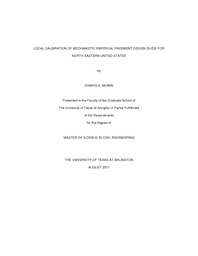
ATTENTION: The works hosted here are being migrated to a new repository that will consolidate resources, improve discoverability, and better show UTA's research impact on the global community. We will update authors as the migration progresses. Please see MavMatrix for more information.
Show simple item record
| dc.contributor.author | Momin, Shariq A. | en_US |
| dc.date.accessioned | 2011-10-11T20:49:11Z | |
| dc.date.available | 2011-10-11T20:49:11Z | |
| dc.date.issued | 2011-10-11 | |
| dc.date.submitted | January 2011 | en_US |
| dc.identifier.other | DISS-11256 | en_US |
| dc.identifier.uri | http://hdl.handle.net/10106/6195 | |
| dc.description.abstract | The Mechanistic-Empirical Pavement Design Guide (MEPDG) developed under the National Cooperative Highway Research Program (NCHRP) 1-37A project is based on mechanistic-empirical analysis of the pavement structure to predict the performance of the pavement under different sets of conditions (traffic, structure and environment). MEPDG takes into account the advanced modeling concepts and pavement performance models in performing the analysis and design of pavement. The mechanistic part of the design concept relies on the application of engineering mechanics to calculate stresses, strains and deformations in the pavement structure induced by the vehicle loads. The empirical part of the concept is based on laboratory developed performance models that are calibrated with the observed distresses in the in-service pavements with known structural properties, traffic loadings, and performances. These models in the MEPDG were calibrated using a national database of pavement performance data (Long Term Pavement Performance, LTPP) and will provide design solution for pavements with a national average performance. In order to improve the performance prediction of the models and the efficiency of the design for a given state, it is necessary to calibrate it to local conditions by taking into consideration local materials, traffic information and the environmental conditions. The objective of this study was to calibrate the MEPDG flexible pavement performance models to local conditions of North Eastern region of United States. To achieve this, seventeen pavement sections were selected for the calibration process and the relevant data (structural, traffic, climatic and pavement performance) was obtained from the LTPP database. MEPDG software (Version 1.1) simulation runs were made using the nationally calibrated coefficients and the predicted distresses were compared with the measured distresses. The predicted distresses showed fair agreement with the measured distresses but still significant differences were found. The difference between the measured and the predicted distresses were minimized through recalibration of the MEPDG distress models. For the permanent deformation models in each layer, a simple linear regression with no intercept was performed and a new set of model coefficients (βr1, βGB, and βSG) for AC, granular base and subgrade layer models were calculated. The calibration of alligator and longitudinal cracking was done by deriving the appropriate model coefficients (C1, C2, and C4) since the fatigue damage is given in MEDPG software output. The coefficients were found using the Microsoft Excel Solver. Thermal cracking model was not calibrated since the measured transverse cracking data in the LTPP database did not increase with time, as it is expected. The calibration of IRI model was done by computing the model coefficients (C1, C2, C3 and C4) based on other distresses by performing a simple linear regression. | en_US |
| dc.description.sponsorship | Romanoschi, Stefan | en_US |
| dc.language.iso | en | en_US |
| dc.publisher | Civil & Environmental Engineering | en_US |
| dc.title | Local Calibration Of Mechanistic Empirical Pavement Design Guide For North Eastern United States | en_US |
| dc.type | M.S. | en_US |
| dc.contributor.committeeChair | Romanoschi, Stefan | en_US |
| dc.degree.department | Civil & Environmental Engineering | en_US |
| dc.degree.discipline | Civil & Environmental Engineering | en_US |
| dc.degree.grantor | University of Texas at Arlington | en_US |
| dc.degree.level | masters | en_US |
| dc.degree.name | M.S. | en_US |
Files in this item
- Name:
- Momin_uta_2502M_11256.pdf
- Size:
- 2.414Mb
- Format:
- PDF
This item appears in the following Collection(s)
Show simple item record


